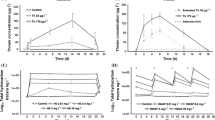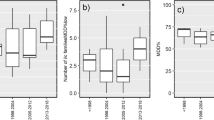Abstract
Many studies investigating the ecotoxicological impacts of industrial effluents on freshwater biota utilize standardized test species suchas the daphnids, Ceriodaphnia dubia, Daphnia magna, and the fathead minnow,Pimephales promelas. Such species may not be the most predictive or ecologically relevant gauges of the responses of instream benthic macroinvertebrates to certain stressors, such as total dissolved solids. An indigenous species approach should be adopted, using a sensitive benthic collector-filterer following development of practical laboratory bioassays. In the Leading Creek Watershed (southeast Ohio), an aggregated ∼ 99% reduction in mean mayfly abundance for all impacted sites was observed below a coal-mine effluent with mean specific conductivity (SC) of 8,109 (7,750–8,750) μS cm-1. The mayfly, Isonychia, was exposed for 7-days to a simulation of this effluent, in lotic microcosms. Based on lowest observable adverse effect concentrations, Isonychia survival was a more sensitiveendpoint to SC (1,562 μS cm-1) than were 7-day C. dubia survival and fecundity (3,730 μS cm-1). Isonychia molting, a potentially more sensitive endpoint, was also examined. Using traditional test species to assess discharges to surface water alone may not adequately protect benthic macroinvertebrate assemblages in systems impaired by discharges high in SC.
Similar content being viewed by others
References
American Public Health Association (APHA): American Water Works Association and Water Environment Federation, 1995. Standard methods for the examination of water and wastewater, 19th ed. American Public Health Association, Wash, D.C.
Black, J. A., Roberts, R. F., Johnson, D. M., Minicucci, D. D. Mancy, K. H. and Allen, H. E.: 1980, The Significance of Physiological Variables in Aquatic Bioassays of Heavy Metals. Water Quality Criteria for Freshwater Fish, Butterworth, London, 259–275.
Buchwalter, D. B., Jenkins, J. J. and Curtis, L. R.: 2002, ‘Respiratory Strategy and Temperature Influences on Contaminant and Water Uptake Rates in Aquatic Insects: Implications for Stressor-Specific Diagnostics’, Annual Meeting of the North American Benthological Society, Pittsburgh, PA (USA), May 28–Jun 1, 2002 (World Meeting Number 000 5892).
Chadwick, M. A. and Feminella, J. W.: 2001, ‘Influence of salinity and temperature on the growth and production of a freshwater mayfly in the Lower Mobile River’, Limnol. Oceanog. 46, 532–542.
Chapman, P. M., Bailey, H. and Canaria, E.: 2000, ‘Toxicity of total dissolved solids associated with two mine effluents to Chironomid larvae and early life stages of rainbow trout’, Environ. Toxicol. Chem. 19, 210–214.
Cherry, D. S., Currie, R. J., Latimer, H. A., Cairns, J., Diz, R. B, Johnson, D. M. and Yeager, M. M.: 1999, ‘Leading Creek Improvement Plan’, Final Report to Southern Ohio Coal Company and American Electric Power, Columbus Ohio.
Cherry, D. S., Van Hassel, J. H., Farris, J. L., Soucek, D. J. and Neves, R. J.: 2002, ‘Site-specific derivation of the acute copper criteria for the Clinch River, Virginia’, Hum. Ecol. Risk Assess. 8, 591–601.
Clements, W. H.: 2000, ‘Integrating effects of contaminants across levels of biological organization: an overview’, J. Aquat. Ecosyst. Stress Recovery 7, 113–116.
Diamond, J. M., Mackler, D. G., Collins, M. and Gruber, D.: 1990, ‘Derivation of a freshwater silver criteria for the New River, Virginia, using representative species’, Environ. Toxicol. Chem. 9, 1425–1434.
Diamond, J. M., Winchester, E. L., Mackler, D. G. and Gruber, D.: 1992, ‘Use of the Mayfly Stenonema modestrum (Heptageniidae) in subacute toxicity assessments’, Environ. Toxicol. Chem. 11, 415–425.
Dickerson, K. K., Hubert, W. A. and Berman, H. L.: 1996, ‘Toxicity assessment of water from lakes and wetlands receiving irrigation drain water’, Environ. Toxicol. Chem. 15, 1097–1101.
Dobbs, M. G., Farris, J. L., Reash, R. J., Cherry, D. S. and Cairns, J.: 1994, ‘Evaluation of the resident-species procedure for developing site-specific water quality criteria for copper in Blaine Creek, Kentucky’, Environ. Toxicol. Chem. 13, 963–971.
Farris, J. L., Cherry, D. S. and Neves, R. J.: 1991, ‘Validation of Copper Concentrations in Laboratory Testing for Site-Specific Copper Criteria in the Clinch River’, Final Report to American Electric Power.
Goetsch, P. A. and Palmer, C. G.: 1996, ‘Salinity tolerances of selected macroinvertebrates of the Sabie River, Kruger National Park, South Africa’, Arch. Environ. Contam. Toxicol. 32, 32–41.
Goodfellow, W. L., Ausley, L. L., Burton, D. T., Denton, D. L., Dorn, P. B., Grothe, D. R., Heber, M. A., Norberg-King and T. J., Rodgers, J. H. Jr.: 2000, ‘Major ion toxicity in effluents: a review with permitting recommendations’, Environ. Toxicol. Chem. 19, 175–182.
Grammeter, S. and Frutiger, A.: 1990, ‘Short-term toxicity of NH3 and low oxygen to benthic macroinvertebrates of running waters and conclusions for wet weather water pollution control measures’, Water Sci. Technol. 10/11, 291–296.
Gulley, D. D.: 1996, TOXSTAT ® . Version 3.3, University of Wyoming Department of Zoology and Physiology, Laramie, WY.
Hart, B. T., Bailey, P., Edwards, R., Hortle, K., James, K., McMahon, A., Meredith, C. and Swadling, K.: 1991, ‘A review of the salt sensitivity of the Australian freshwater biota’, Hydrobiologia 210, 105–144.
Ingersoll, C. G., Dwyer, F. J., Burch, S. A., Nelson, M. K., Buckler, D. R. and Hunn, J. B.: 1992, ‘The use of freshwater and saltwater animals to distinguish between the toxic effects of salinity and contaminants in irrigation drain water’, Environ. Toxicol. Chem. 11, 503–511.
Kennedy, A. J., Cherry, D. S. and Currie, R. J.: 2003, ‘Field and laboratory assessment of a coal processing effluent in the leading creek watershed, Meigs Co., Ohio’, Arch. Environ. Contam. Toxicol. 44, 324–331.
Kobuszewski, D. M. and Perry, S. A.: 1994, ‘Secondary production of Rhyacophilia, Ameletus sp., and Isonychia bicolor from streams of low and circumneutral pH in the Appalachian Mountains and West Virginia’, Hydrobiologia 273, 163–169.
Koel, T. M. and Peterka, J. J.: 1995, ‘Survival to hatching of fishes in sulfate-saline waters, Devils Lake, North Dakota’, Can. J. Fish Aquat. Sci. 52, 464–469.
Kondratieff, B. C. and Voshell, J. R.: 1984, ‘The north and central species of Isonychia (Ephemeroptera: Oligoneuriidae)’, Trans. Amer. Entomol. 110, 129–244.
Lechleitner, R. A., Cherry, D. S., Cairns, J. C. Jr. and D. A. Stetler: 1985, ‘Ionoregulatory and toxicological responses of stonefly nymphs (Plecoptera) to acidic and alkaline pH’, Arch. Environ. Contam. Toxicol. 14, 179–185.
Masnado, R. G., Geis, S. W. and Sonzogogni, W. C.: 1995, ‘Comparative acute toxicity of a synthetic mine effluent to Ceriodaphnia dubia, larval Fathead Minnow and the freshwater mussel Anodonta imbecilis’, Environ. Toxicol. Chem. 14, 1913–1920.
Merritt, R. W. and Cummins, K. W.: 1996, An Introduction to the Aquatic Insects of North America, 3rd addition. Kendall/Hunt Publishing Company, Dubuque, IA 52002.
Morris, R. J., Lockwood, A. P. M., Dyball, D. and Bolt, S. R. L.: 1987, ‘Changes in the fatty acid composition of the gill phospholipids in Gammarus duebeni during moult: Evidence for reduced permeability of the gill membrane’, Com. Biochem. Physiol. 88B, 257–260.
Mount, D. R., Gulley, D. D., Hockett, J. R., Garrison, T. D. and Evans, J. M.: 1997, ‘Statistical models to predict the toxicity of major ions to Ceriodaphnia dubia, Daphnia magna and Pimephales promelas (Fathead Minnows)’, Environ. Toxicol. Chem. 16, 2009–2019.
Pennak, R. W.: 1989, Freshwater Invertebrates of the United States, 3rd edition. John Wiley & Sons, Inc. New York.
Peters, G. T., Cherry, D. S. and Cairns, J. C. Jr.: 1985, ‘Responses of Isonychia bicolor to alkaline pH: an evaluation of survival, oxygen consumption, and chloride cell ultrastructure’, Can. J. Fish. Aquat. Sci. 42, 1088–1095.
Pontasch, K. W. and Cairns, J. Jr.: 1988, ‘Establishing and maintaining laboratory-based microcosms of riffle insect communities: their potential for multispecies toxicity tests’, Hydrobiologia 175, 49–60.
Rosenberg, D. M. and Resh, V. H.: 1996, ‘Use of Aaquatic Insects in Biomonitoring’, in An Introduction to the Aquatic Insects of North America, 3rd edition. Kendall/Hunt Publishing Company, Dubuque, IA 52002. pp. 87–97.
Sall, J. and Lehman, A.: 1996, JMP Start Statistics. SAS Institute. Duxbury Press, Belmont, CA.
Sherberger, F. F., Benfield, E. F., Dickson, K. L. and Cairns, J. Jr.: 1977, ‘Effects of thermal shocks on drifting aquatic insects: a laboratory simulation’, J. Fish. Res. B. Can. 34, 529–536.
Short, T. M., Black, J. A. and Birge, W. J.: 1991, ‘Ecology of a saline stream: community responses to spatial gradients of environmental conditions’, Hydrobiologia 226, 167–178.
Sibley, P. K. and Kaushik, N. K.: 1991, ‘Toxicity of microencapsulated permethrin to selected nontarget aquatic invertebrates’, Arch. Environ. Contam. Toxicol. 20, 168–176.
Sweeney, B. W.: 1978, ‘Bioenergetic and development response of a mayfly to thermal variation’, Limnol. Oceanogr. 23, 461–477.
US EPA: 1994, ‘short-Term Methods for Estimating the Chronic Toxicity of Effluents and Receiving Water to Freshwater Organisms’, 3rd ed. Washington D.C. EPA-600-4-91-002.
US EPA: 1999, ‘Update of Ambient Water Quality for Ammonia’, Office of Water, Office of Science and Technology, Washington, D.C. EPA-822-R-99-014.
Wallace, J. B. and O'Hop, J.: 1979, ‘Fine particle suspension-feeding capabilities of Isonychia spp. (Ephemeroptera: Siphlonuridae)’, Ann. Entomol. Soc. Am. 72, 353–357.
Wichard, W., Tsui, P. T. P. and Komnick, H.: 1973, ‘Effect of different salinities on the coniform chloride cells of mayfly larvae’, J. Insect Physiol. 19, 1825–1835.
Williams, D. D. and Williams, N. E.: 1998, ‘Aquatic insects in an estuarine environment: densities, distribution and salinity tolerance’, Freshw. Biol. 39, 411–421.
Williams, K. A., Green, D. W. J. and Pascoe, D.: 1986, ‘Studies on the acute toxicity of pollutants to freshwater macroinvertebrates: 3. Ammonia’, Arch. Hydrobiol. 106, 61–70.
Author information
Authors and Affiliations
Corresponding author
Rights and permissions
About this article
Cite this article
Kennedy, A.J., Cherry, D.S. & Currie, R.J. Evaluation of Ecologically Relevant Bioassays for a Lotic System impacted by a Coal-mine effluent, using Isonychia . Environ Monit Assess 95, 37–55 (2004). https://doi.org/10.1023/B:EMAS.0000029896.97074.1e
Issue Date:
DOI: https://doi.org/10.1023/B:EMAS.0000029896.97074.1e




